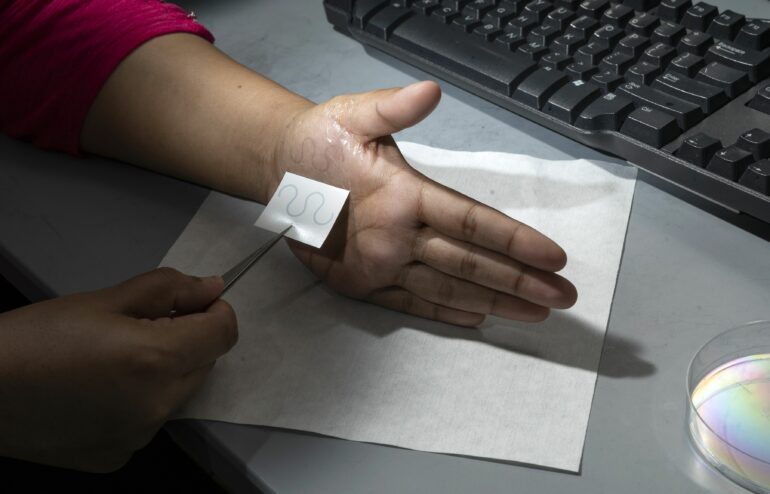Researchers at the University of Texas at Austin have developed a temporary “e-tattoo” for the palm that can track excitement and stress using the skin’s electrical conductivity. The e-tattoo could be a reliable way for people with conditions such as anxiety or depression to track their emotions.
In a research paper published in the journal Nature Communications, the palm tattoo stayed on for 15 hours while subjects did everyday activities such as driving, eating and exercising.
Nanshu Lu, a professor at the University of Texas at Austin’s Cockrell School of Engineering, said the e-tattoo could allow patients to track stress levels without wearing a bulky medical device.
“This is such an ultrathin and invisible tattoo,” said Lu, an author on the study, “but mechanically, it’s resilient enough to survive all kinds of … activities.”
What is an e-tattoo?
For decades, doctors have placed electrodes on the body to read electrical signals from the brain and heart. Electronic devices that tell us about our health, such as blood pressure monitors, are commonly used at the doctor’s office.
Some of the first “electronic tattoos” were made to deliver drugs such as opioids, according to Aaron Franklin, a professor of electrical and computer engineering at Duke University. In the last 5 to 10 years, he said, there’s been a push to develop wearable electronic sensors, like Fitbit trackers and smart watches, to monitor health throughout the day instead of only at doctors’ appointments.
Lu has studied e-tattoos for over 12 years. She created a stretchable chest tattoo to monitor heart health and was awarded a $1.5 million grant to design an e-tattoo that tracks pneumonia symptoms. She wants to create sensors to collect important medical data that are easy to wear and use.
The goal, she said, is to make electronics, whether they’re sensors or processors, “as soft and stretchy as human tissue.”
Stress, sweat and sensors
When we experience strong emotions such as excitement and stress, our eccrine sweat glands fill up, making our skin more electrically conductive. Smart watches can contain wrist sensors that measure skin conductivity to track stress levels.
Lu upped the ante, tracking stress in an area of the body that contains the highest concentration of eccrine sweat glands: the palm. An e-tattoo for the palm would give the wearer more accurate stress readings than a smart watch, Lu said, but the tattoo would need to stay on one of the most active parts of the body.
Right now, scientists collect eccrine sweat gland data from the palm by attaching gel electrodes with dangling wires that connect to a wristwatch. Gel electrodes are stiff and bulky and can fall off during everyday activities, Lu said.
Lu’s palm e-tattoo goes on just like a temporary tattoo. Her team also created two S-shaped gold ribbons that snake across the palm and connect the palm tattoo to a wristwatch. The wristwatch wirelessly sends the data to a smartphone, where the wearer can read it.
The gold ribbons are extremely thin, just 750 nanometers thick. A sheet of paper, for reference, is about 100,000 nanometers thick.
In the lab, Lu’s team first confirmed that the e-tattoo gave similar readings to the gel electrodes. Then they attached two identical watches to the wrists of two people. One watch was connected to gel electrodes on the palm. The other was connected to the ultrathin gold ribbons and the e-tattoo.
They collected data for 15 hours while the people went through everyday motions like studying, eating, exercising and sleeping. The gel electrodes fell off three to five times over the 15 hours. The e-tattoo didn’t fall off.
Reliable and reproducible
Lu’s team is not the first to develop an e-tattoo, but it is one of the first to create one for the palm.
For e-tattoos to be used widely in the medical world, they need to conquer two key obstacles, according to Franklin at Duke University. First, their data readings need to be consistently correct. Second, they need to collect reliable data with many different patients—those who naturally sweat more or have different skin types, for example.
“Those are the kinds of big problems that await any technology that’s going to move past a really nice research paper, which this is,” said Franklin, who was not involved with Lu’s research.
For Lu’s palm e-tattoo to track anxiety and depression, it would need FDA approval. Her plan is to keep fine-tuning the tattoo to provide accurate, continuous information about excitement and stress levels.
Lu sees e-tattoos as a way to “digitize” the human body. She noted a pattern in tech development over the years: Humans are becoming more digital as robots begin to adopt the skills and intelligence of humans. Her goal is to bring humans even closer to bridging that gap.
More information:
Hongwoo Jang et al, Graphene e-tattoos for unobstructive ambulatory electrodermal activity sensing on the palm enabled by heterogeneous serpentine ribbons, Nature Communications (2022). DOI: 10.1038/s41467-022-34406-2
2023 The Dallas Morning News.
Distributed by Tribune Content Agency, LLC.
Citation:
This ‘electronic tattoo’ can tell when you’re stressed out (2023, March 20)



